Abstract
1. Binding of the peripheral benzodiazepine receptor ligand, [3H]-PK 11195, to rat hippocampal membranes has been used to quantify the reactive gliosis resulting from neuronal death induced by intraperitoneally administered kainic acid. 2. Intraperitoneal administration of kainic acid (10 mg kg-1) caused a 350-500% increase in [3H]-PK 11195 binding measured in rat hippocampal P2 membranes 7 days later. Co-treatment with the adenosine derivative R-phenylisopropyladenosine (R-PIA) (100, 25 or 10 micrograms kg-1, i.p.) abolished this elevation. The protective action of R-PIA could itself be abolished by co-treatment with 8-phenyltheophylline (1 mg kg-1). 3. Body temperatures were recorded in the antagonist experiments and no significant changes were recorded, suggesting that the protective action of R-PIA was not mediated by hypothermia. 4. Since systemic kainic acid-induced neurotoxicity has been claimed as a good model of neuronal death in temporal lobe epilepsy, the results suggest that the systemic administration of purines in low doses may provide protection against certain neurodegenerative insults.
Full text
PDF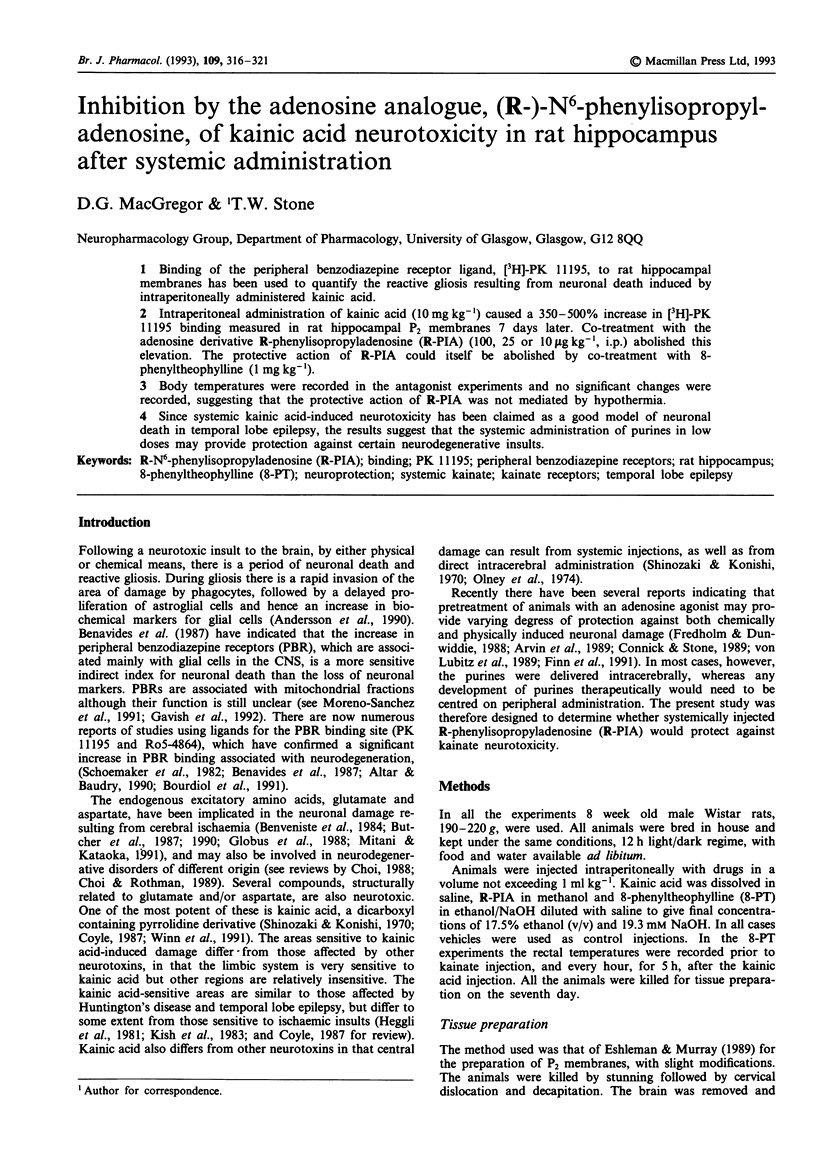
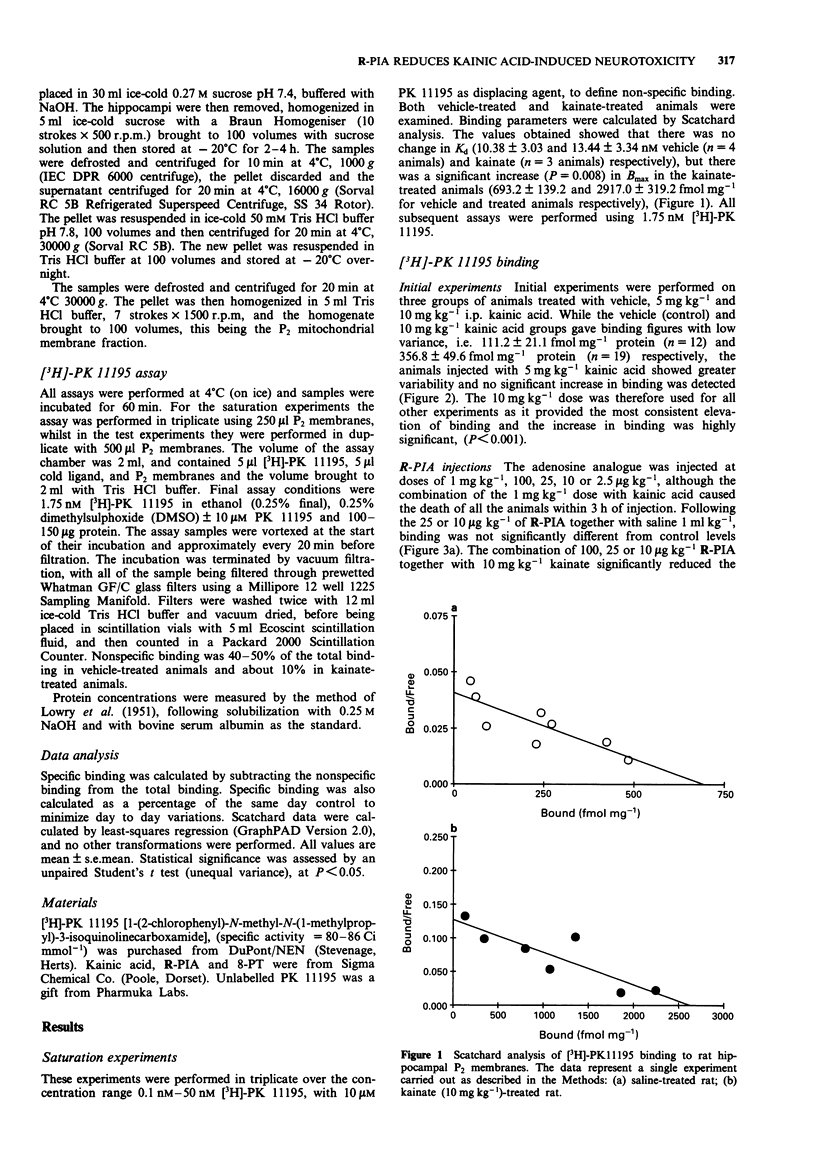
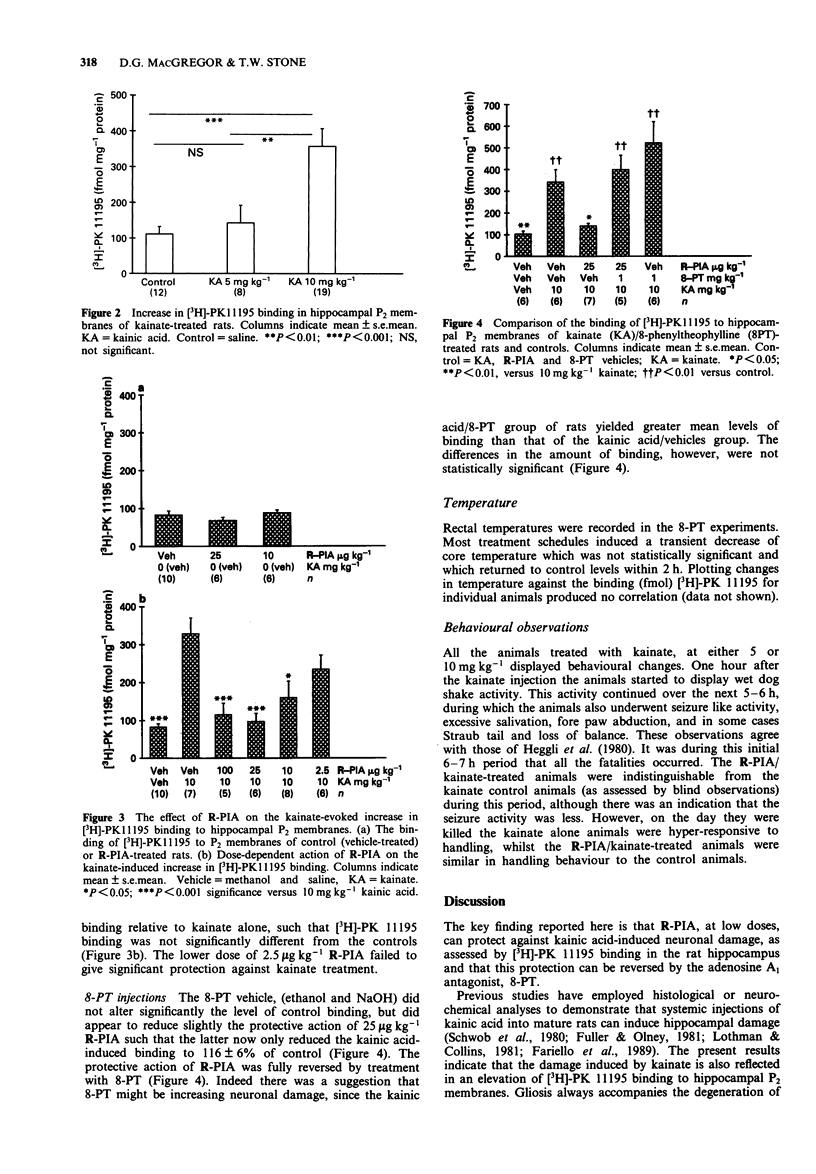
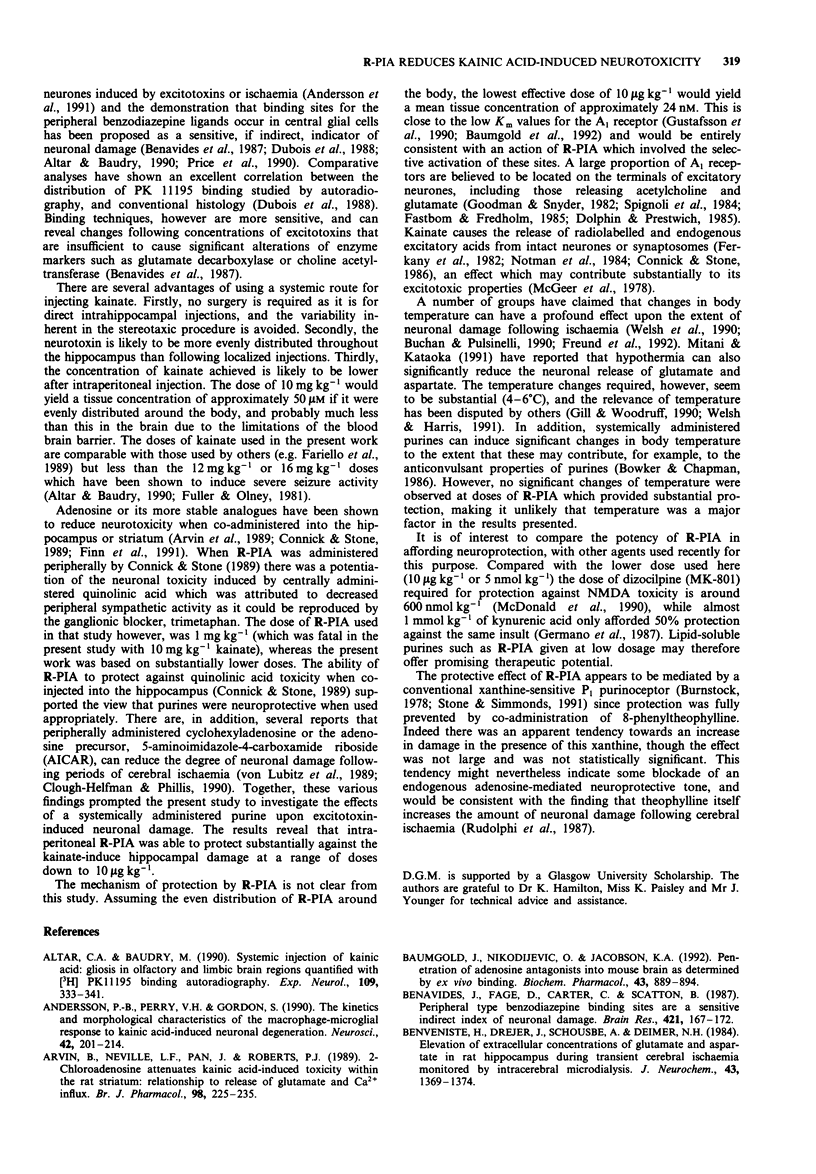
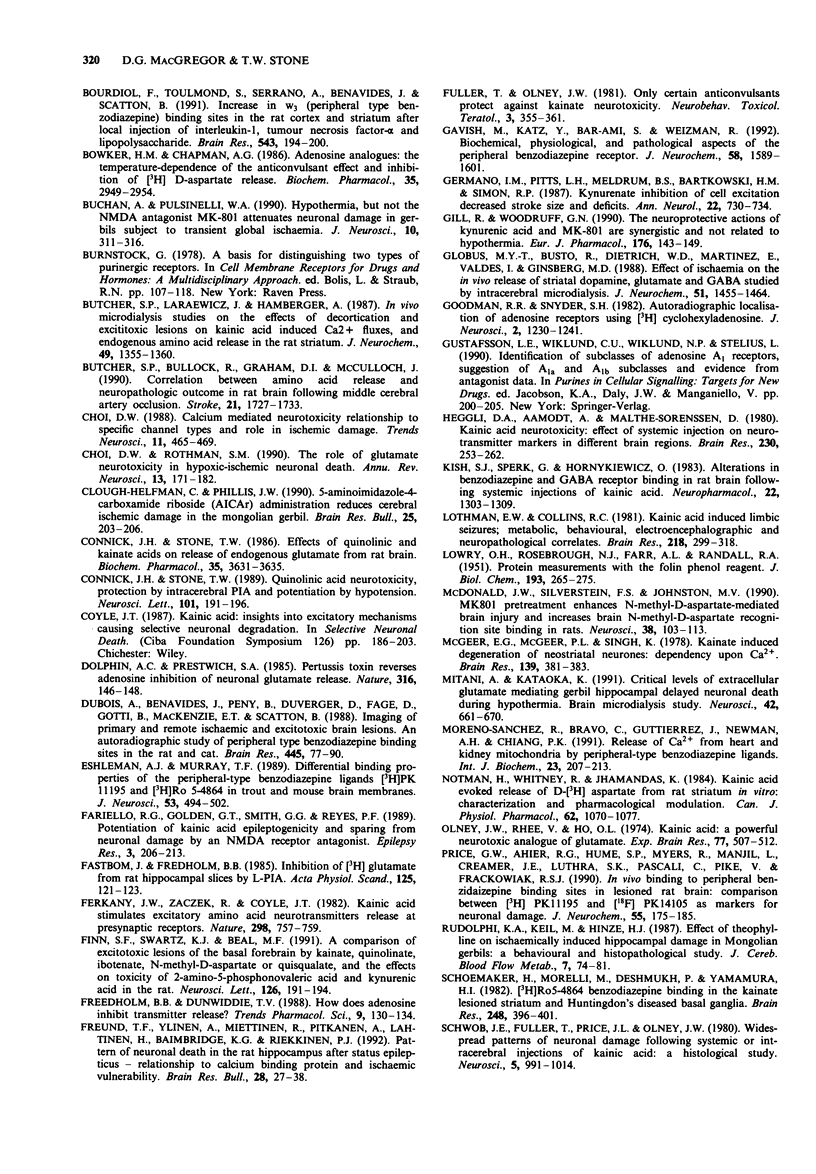
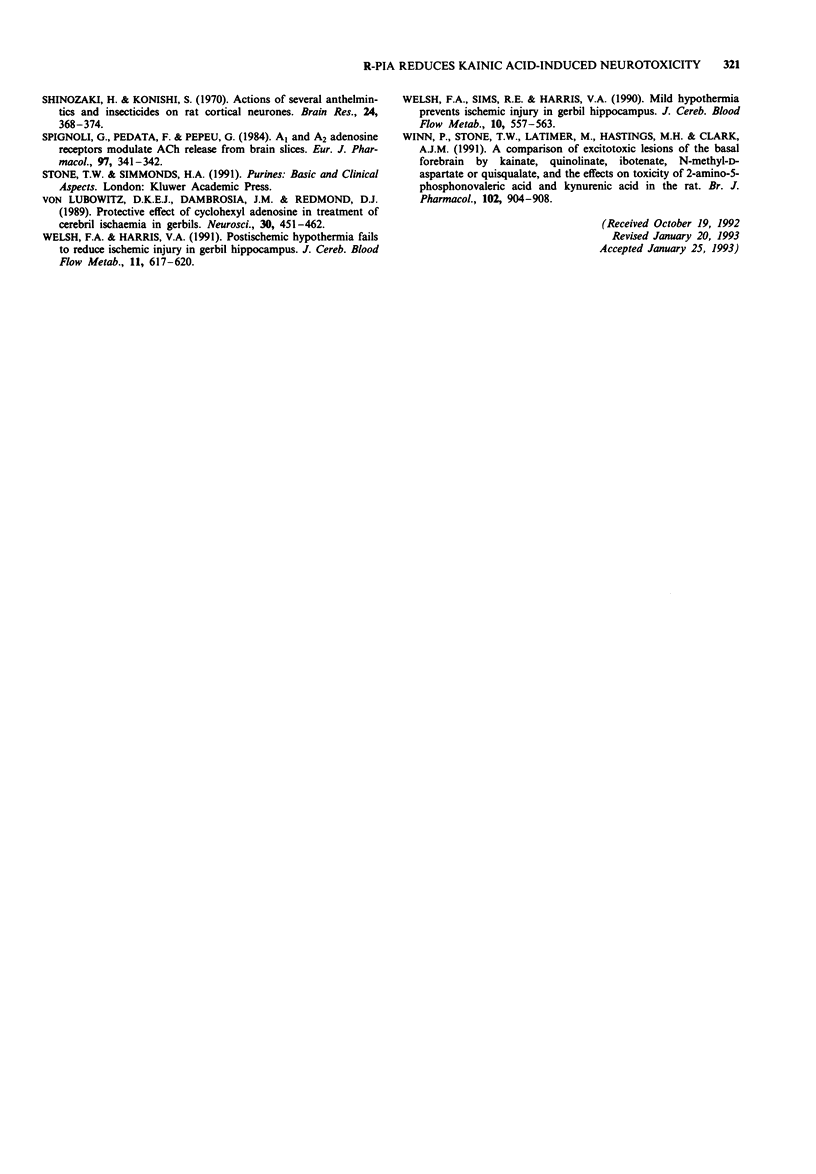
Selected References
These references are in PubMed. This may not be the complete list of references from this article.
- Altar C. A., Baudry M. Systemic injection of kainic acid: gliosis in olfactory and limbic brain regions quantified with [3H]PK 11195 binding autoradiography. Exp Neurol. 1990 Sep;109(3):333–341. doi: 10.1016/s0014-4886(05)80024-x. [DOI] [PubMed] [Google Scholar]
- Andersson P. B., Perry V. H., Gordon S. The kinetics and morphological characteristics of the macrophage-microglial response to kainic acid-induced neuronal degeneration. Neuroscience. 1991;42(1):201–214. doi: 10.1016/0306-4522(91)90159-l. [DOI] [PubMed] [Google Scholar]
- Arvin B., Neville L. F., Pan J., Roberts P. J. 2-chloroadenosine attenuates kainic acid-induced toxicity within the rat straitum: relationship to release of glutamate and Ca2+ influx. Br J Pharmacol. 1989 Sep;98(1):225–235. doi: 10.1111/j.1476-5381.1989.tb16886.x. [DOI] [PMC free article] [PubMed] [Google Scholar]
- Baumgold J., Nikodijevic O., Jacobson K. A. Penetration of adenosine antagonists into mouse brain as determined by ex vivo binding. Biochem Pharmacol. 1992 Feb 18;43(4):889–894. doi: 10.1016/0006-2952(92)90257-j. [DOI] [PMC free article] [PubMed] [Google Scholar]
- Benavides J., Fage D., Carter C., Scatton B. Peripheral type benzodiazepine binding sites are a sensitive indirect index of neuronal damage. Brain Res. 1987 Sep 22;421(1-2):167–172. doi: 10.1016/0006-8993(87)91287-x. [DOI] [PubMed] [Google Scholar]
- Benveniste H., Drejer J., Schousboe A., Diemer N. H. Elevation of the extracellular concentrations of glutamate and aspartate in rat hippocampus during transient cerebral ischemia monitored by intracerebral microdialysis. J Neurochem. 1984 Nov;43(5):1369–1374. doi: 10.1111/j.1471-4159.1984.tb05396.x. [DOI] [PubMed] [Google Scholar]
- Bourdiol F., Toulmond S., Serrano A., Benavides J., Scatton B. Increase in omega 3 (peripheral type benzodiazepine) binding sites in the rat cortex and striatum after local injection of interleukin-1, tumour necrosis factor-alpha and lipopolysaccharide. Brain Res. 1991 Mar 15;543(2):194–200. doi: 10.1016/0006-8993(91)90028-t. [DOI] [PubMed] [Google Scholar]
- Bowker H. M., Chapman A. G. Adenosine analogues. The temperature-dependence of the anticonvulsant effect and inhibition of 3H-D-aspartate release. Biochem Pharmacol. 1986 Sep 1;35(17):2949–2953. doi: 10.1016/0006-2952(86)90491-0. [DOI] [PubMed] [Google Scholar]
- Buchan A., Pulsinelli W. A. Hypothermia but not the N-methyl-D-aspartate antagonist, MK-801, attenuates neuronal damage in gerbils subjected to transient global ischemia. J Neurosci. 1990 Jan;10(1):311–316. doi: 10.1523/JNEUROSCI.10-01-00311.1990. [DOI] [PMC free article] [PubMed] [Google Scholar]
- Butcher S. P., Bullock R., Graham D. I., McCulloch J. Correlation between amino acid release and neuropathologic outcome in rat brain following middle cerebral artery occlusion. Stroke. 1990 Dec;21(12):1727–1733. doi: 10.1161/01.str.21.12.1727. [DOI] [PubMed] [Google Scholar]
- Butcher S. P., Lazarewicz J. W., Hamberger A. In vivo microdialysis studies on the effects of decortication and excitotoxic lesions on kainic acid-induced calcium fluxes, and endogenous amino acid release, in the rat striatum. J Neurochem. 1987 Nov;49(5):1355–1360. doi: 10.1111/j.1471-4159.1987.tb00999.x. [DOI] [PubMed] [Google Scholar]
- Choi D. W. Calcium-mediated neurotoxicity: relationship to specific channel types and role in ischemic damage. Trends Neurosci. 1988 Oct;11(10):465–469. doi: 10.1016/0166-2236(88)90200-7. [DOI] [PubMed] [Google Scholar]
- Choi D. W., Rothman S. M. The role of glutamate neurotoxicity in hypoxic-ischemic neuronal death. Annu Rev Neurosci. 1990;13:171–182. doi: 10.1146/annurev.ne.13.030190.001131. [DOI] [PubMed] [Google Scholar]
- Clough-Helfman C., Phillis J. W. 5-Aminoimidazole-4-carboxamide riboside (AICAr) administration reduces cerebral ischemic damage in the Mongolian gerbil. Brain Res Bull. 1990 Jul;25(1):203–206. doi: 10.1016/0361-9230(90)90277-7. [DOI] [PubMed] [Google Scholar]
- Connick J. H., Stone T. W. Quinolinic acid neurotoxicity: protection by intracerebral phenylisopropyladenosine (PIA) and potentiation by hypotension. Neurosci Lett. 1989 Jun 19;101(2):191–196. doi: 10.1016/0304-3940(89)90529-6. [DOI] [PubMed] [Google Scholar]
- Connick J. H., Stone T. W. The effect of kainic, quinolinic and beta-kainic acids on the release of endogenous amino acids from rat brain slices. Biochem Pharmacol. 1986 Oct 15;35(20):3631–3635. doi: 10.1016/0006-2952(86)90636-2. [DOI] [PubMed] [Google Scholar]
- Coyle J. T. Kainic acid: insights into excitatory mechanisms causing selective neuronal degeneration. Ciba Found Symp. 1987;126:186–203. doi: 10.1002/9780470513422.ch12. [DOI] [PubMed] [Google Scholar]
- Dolphin A. C., Prestwich S. A. Pertussis toxin reverses adenosine inhibition of neuronal glutamate release. Nature. 1985 Jul 11;316(6024):148–150. doi: 10.1038/316148a0. [DOI] [PubMed] [Google Scholar]
- Dubois A., Bénavidès J., Peny B., Duverger D., Fage D., Gotti B., MacKenzie E. T., Scatton B. Imaging of primary and remote ischaemic and excitotoxic brain lesions. An autoradiographic study of peripheral type benzodiazepine binding sites in the rat and cat. Brain Res. 1988 Mar 29;445(1):77–90. doi: 10.1016/0006-8993(88)91076-1. [DOI] [PubMed] [Google Scholar]
- Eshleman A. J., Murray T. F. Differential binding properties of the peripheral-type benzodiazepine ligands [3H]PK 11195 and [3H]Ro 5-4864 in trout and mouse brain membranes. J Neurochem. 1989 Aug;53(2):494–502. doi: 10.1111/j.1471-4159.1989.tb07361.x. [DOI] [PubMed] [Google Scholar]
- Fariello R. G., Golden G. T., Smith G. G., Reyes P. F. Potentiation of kainic acid epileptogenicity and sparing from neuronal damage by an NMDA receptor antagonist. Epilepsy Res. 1989 May-Jun;3(3):206–213. doi: 10.1016/0920-1211(89)90025-9. [DOI] [PubMed] [Google Scholar]
- Fastbom J., Fredholm B. B. Inhibition of [3H] glutamate release from rat hippocampal slices by L-phenylisopropyladenosine. Acta Physiol Scand. 1985 Sep;125(1):121–123. doi: 10.1111/j.1748-1716.1985.tb07698.x. [DOI] [PubMed] [Google Scholar]
- Ferkany J. W., Zaczek R., Coyle J. T. Kainic acid stimulates excitatory amino acid neurotransmitter release at presynaptic receptors. Nature. 1982 Aug 19;298(5876):757–759. doi: 10.1038/298757a0. [DOI] [PubMed] [Google Scholar]
- Finn S. F., Swartz K. J., Beal M. F. 2-Chloroadenosine attenuates NMDA, kainate, and quisqualate toxicity. Neurosci Lett. 1991 May 27;126(2):191–194. doi: 10.1016/0304-3940(91)90551-4. [DOI] [PubMed] [Google Scholar]
- Fredholm B. B., Dunwiddie T. V. How does adenosine inhibit transmitter release? Trends Pharmacol Sci. 1988 Apr;9(4):130–134. doi: 10.1016/0165-6147(88)90194-0. [DOI] [PubMed] [Google Scholar]
- Freund T. F., Ylinen A., Miettinen R., Pitkänen A., Lahtinen H., Baimbridge K. G., Riekkinen P. J. Pattern of neuronal death in the rat hippocampus after status epilepticus. Relationship to calcium binding protein content and ischemic vulnerability. Brain Res Bull. 1992 Jan;28(1):27–38. doi: 10.1016/0361-9230(92)90227-o. [DOI] [PubMed] [Google Scholar]
- Fuller T. A., Olney J. W. Only certain anticonvulsants protect against kainate neurotoxicity. Neurobehav Toxicol Teratol. 1981 Fall;3(3):355–361. [PubMed] [Google Scholar]
- Gavish M., Katz Y., Bar-Ami S., Weizman R. Biochemical, physiological, and pathological aspects of the peripheral benzodiazepine receptor. J Neurochem. 1992 May;58(5):1589–1601. doi: 10.1111/j.1471-4159.1992.tb10030.x. [DOI] [PubMed] [Google Scholar]
- Germano I. M., Pitts L. H., Meldrum B. S., Bartkowski H. M., Simon R. P. Kynurenate inhibition of cell excitation decreases stroke size and deficits. Ann Neurol. 1987 Dec;22(6):730–734. doi: 10.1002/ana.410220609. [DOI] [PubMed] [Google Scholar]
- Gill R., Woodruff G. N. The neuroprotective actions of kynurenic acid and MK-801 in gerbils are synergistic and not related to hypothermia. Eur J Pharmacol. 1990 Feb 6;176(2):143–149. doi: 10.1016/0014-2999(90)90522-8. [DOI] [PubMed] [Google Scholar]
- Globus M. Y., Busto R., Dietrich W. D., Martinez E., Valdes I., Ginsberg M. D. Effect of ischemia on the in vivo release of striatal dopamine, glutamate, and gamma-aminobutyric acid studied by intracerebral microdialysis. J Neurochem. 1988 Nov;51(5):1455–1464. doi: 10.1111/j.1471-4159.1988.tb01111.x. [DOI] [PubMed] [Google Scholar]
- Goodman R. R., Synder S. H. Autoradiographic localization of adenosine receptors in rat brain using [3H]cyclohexyladenosine. J Neurosci. 1982 Sep;2(9):1230–1241. doi: 10.1523/JNEUROSCI.02-09-01230.1982. [DOI] [PMC free article] [PubMed] [Google Scholar]
- Heggli D. E., Aamodt A., Malthe-Sørenssen D. Kainic acid neurotoxicity; effect of systemic injection on neurotransmitter markers in different brain regions. Brain Res. 1981 Dec 28;230(1-2):253–262. doi: 10.1016/0006-8993(81)90405-4. [DOI] [PubMed] [Google Scholar]
- Januszewicz von Lubitz D. K., Dambrosia J. M., Redmond D. J. Protective effect of cyclohexyl adenosine in treatment of cerebral ischemia in gerbils. Neuroscience. 1989;30(2):451–462. doi: 10.1016/0306-4522(89)90265-0. [DOI] [PubMed] [Google Scholar]
- Kish S. J., Sperk G., Hornykiewicz O. Alterations in benzodiazepine and GABA receptor binding in rat brain following systemic injection of kainic acid. Neuropharmacology. 1983 Nov;22(11):1303–1309. doi: 10.1016/0028-3908(83)90204-6. [DOI] [PubMed] [Google Scholar]
- LOWRY O. H., ROSEBROUGH N. J., FARR A. L., RANDALL R. J. Protein measurement with the Folin phenol reagent. J Biol Chem. 1951 Nov;193(1):265–275. [PubMed] [Google Scholar]
- Lothman E. W., Collins R. C. Kainic acid induced limbic seizures: metabolic, behavioral, electroencephalographic and neuropathological correlates. Brain Res. 1981 Aug 10;218(1-2):299–318. doi: 10.1016/0006-8993(81)91308-1. [DOI] [PubMed] [Google Scholar]
- McDonald J. W., Silverstein F. S., Johnston M. V. MK-801 pretreatment enhances N-methyl-D-aspartate-mediated brain injury and increases brain N-methyl-D-aspartate recognition site binding in rats. Neuroscience. 1990;38(1):103–113. doi: 10.1016/0306-4522(90)90377-g. [DOI] [PubMed] [Google Scholar]
- McGeer E. G., McGeer P. L., Singh K. Kainate-induced degeneration of neostriatal neurons: dependency upon corticostriatal tract. Brain Res. 1978 Jan 13;139(2):381–383. doi: 10.1016/0006-8993(78)90941-1. [DOI] [PubMed] [Google Scholar]
- Mitani A., Kataoka K. Critical levels of extracellular glutamate mediating gerbil hippocampal delayed neuronal death during hypothermia: brain microdialysis study. Neuroscience. 1991;42(3):661–670. doi: 10.1016/0306-4522(91)90035-m. [DOI] [PubMed] [Google Scholar]
- Moreno-Sánchez R., Bravo C., Gutiérrez J., Newman A. H., Chiang P. K. Release of Ca2+ from heart and kidney mitochondria by peripheral-type benzodiazepine receptor ligands. Int J Biochem. 1991;23(2):207–213. doi: 10.1016/0020-711x(91)90191-o. [DOI] [PubMed] [Google Scholar]
- Notman H., Whitney R., Jhamandas K. Kainic acid evoked release of D-[3H]aspartate from rat striatum in vitro: characterization and pharmacological modulation. Can J Physiol Pharmacol. 1984 Sep;62(9):1070–1077. doi: 10.1139/y84-179. [DOI] [PubMed] [Google Scholar]
- Olney J. W., Rhee V., Ho O. L. Kainic acid: a powerful neurotoxic analogue of glutamate. Brain Res. 1974 Sep 13;77(3):507–512. doi: 10.1016/0006-8993(74)90640-4. [DOI] [PubMed] [Google Scholar]
- Price G. W., Ahier R. G., Hume S. P., Myers R., Manjil L., Cremer J. E., Luthra S. K., Pascali C., Pike V., Frackowiak R. S. In vivo binding to peripheral benzodiazepine binding sites in lesioned rat brain: comparison between [3H]PK11195 and [18F]PK14105 as markers for neuronal damage. J Neurochem. 1990 Jul;55(1):175–185. doi: 10.1111/j.1471-4159.1990.tb08836.x. [DOI] [PubMed] [Google Scholar]
- Rudolphi K. A., Keil M., Hinze H. J. Effect of theophylline on ischemically induced hippocampal damage in Mongolian gerbils: a behavioral and histopathological study. J Cereb Blood Flow Metab. 1987 Feb;7(1):74–81. doi: 10.1038/jcbfm.1987.11. [DOI] [PubMed] [Google Scholar]
- Schoemaker H., Morelli M., Deshmukh P., Yamamura H. I. [3H]Ro5-4864 benzodiazepine binding in the kainate lesioned striatum and Huntington's diseased basal ganglia. Brain Res. 1982 Sep 30;248(2):396–401. doi: 10.1016/0006-8993(82)90602-3. [DOI] [PubMed] [Google Scholar]
- Schwob J. E., Fuller T., Price J. L., Olney J. W. Widespread patterns of neuronal damage following systemic or intracerebral injections of kainic acid: a histological study. Neuroscience. 1980;5(6):991–1014. doi: 10.1016/0306-4522(80)90181-5. [DOI] [PubMed] [Google Scholar]
- Shinozaki H., Konishi S. Actions of several anthelmintics and insecticides on rat cortical neurones. Brain Res. 1970 Dec 1;24(2):368–371. doi: 10.1016/0006-8993(70)90122-8. [DOI] [PubMed] [Google Scholar]
- Spignoli G., Pedata F., Pepeu G. A1 and A2 adenosine receptors modulate acetylcholine release from brain slices. Eur J Pharmacol. 1984 Jan 27;97(3-4):341–342. doi: 10.1016/0014-2999(84)90475-8. [DOI] [PubMed] [Google Scholar]
- Welsh F. A., Harris V. A. Postischemic hypothermia fails to reduce ischemic injury in gerbil hippocampus. J Cereb Blood Flow Metab. 1991 Jul;11(4):617–620. doi: 10.1038/jcbfm.1991.112. [DOI] [PubMed] [Google Scholar]
- Welsh F. A., Sims R. E., Harris V. A. Mild hypothermia prevents ischemic injury in gerbil hippocampus. J Cereb Blood Flow Metab. 1990 Jul;10(4):557–563. doi: 10.1038/jcbfm.1990.98. [DOI] [PubMed] [Google Scholar]
- Winn P., Stone T. W., Latimer M., Hastings M. H., Clark A. J. A comparison of excitotoxic lesions of the basal forebrain by kainate, quinolinate, ibotenate, N-methyl-D-aspartate or quisqualate, and the effects on toxicity of 2-amino-5-phosphonovaleric acid and kynurenic acid in the rat. Br J Pharmacol. 1991 Apr;102(4):904–908. doi: 10.1111/j.1476-5381.1991.tb12274.x. [DOI] [PMC free article] [PubMed] [Google Scholar]


